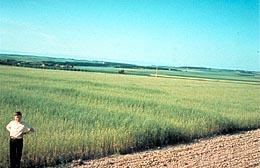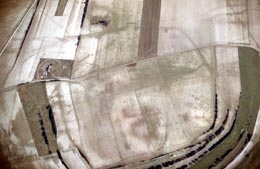- Home
- What is aerial archaeology ?
- Portrait of Roger Agache
- First aerial flyovers
Roger Agache's first convincing discovery in 1962: a typical entrance to a Roman camp on Mont Câtelet at Vendeuil-Caply (Oise).
In 1955 and 1956, Roger Agache made his first aerial flyovers above the villages that he loved the most, with no other goal — and obviously with no other result — than the marvelous sensation that a low-altitude aerial view produces!
Léon Aufrère, the historian and geographer, encouraged him to go through aerial images in the same way that professor Le Gall had done for Vieil-Evreux. Aufrère had him study the archaeological photographs of the English specialists, as well as the rare images that had already been published in France by Pierre Parruzot, D. Diehl, Roger Chevallier and Bernard Edeine. Finally, he urged Agache to take up aerial prospecting over the sites that Agache was excavating, particularly around the Neolithic mines at Hardivillers (Oise).
An immediate check at ground level, followed by an excavation that convinced the skeptics.
These occasional flyovers did not produce immediate results. Curiously, however, it was often during the flights back that Roger Agache by chance noted lines similar to those in the publications of O.G.S. Crawford. This encouraged him to extend his flyovers, the results of which he began to publish as of 1960.
He met with only skepticism and irony, despite convincing test excavations. Professor Ernest Will, however, gave Agache his unwavering support. In 1961, during the presentation of his results to the French Prehistoric Society, he received the support of Raymond Chevallier, whose photographic interpretations courses he had been following. He then threw himself headlong into this discipline that was still so controversial in France. The following two years were fruitful ones, and he managed to obtain, especially at Vendeuil-Caply (Oise), photographs that revealed such characteristic Roman structures that he began to be taken seriously.
A few years later, the same site, revealed in its entirety thanks to the presence of morning dew.


